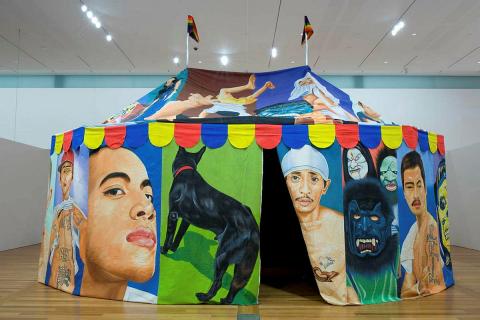David Griggs – Frog boy’s dissertation
By Julie Ewington
Artlines | 3-2009 | September 2009
David Griggs is one of the most distinctive younger painters in Australia today. He harnesses the emotional impact of figurative art and applies it to contemporary social issues, creating provocative juxtapositions of imagery exploring the darker side of life. Griggs often works with extravagant installations of paintings that are massed to create an effect of stimulating, even overwhelming, challenge: it’s as if a myriad of images and ideas, taken from sources as various as comics, street art and all manner of contemporary issues, meet in a clash of competing energies and desires. His art is confident, ebullient and abrasive and in recent years has been included in a number of major exhibitions.
Since receiving an Asialink grant for a residency at Ateneo University de Manila in 2005, however, Griggs has spent significant periods working in the Philippines. Fascinated by the extremes of life there, as much as by the lively visual culture of the country, he has often collaborated with traditionally trained Philippine movie billboard painters, who still make many billboards in the laborious time-honoured manner, painting them entirely by hand. Griggs commissioned Frog boy’s dissertation into a new karaoke cult 2008 from a team of Manila painters, and under his direction they decorated this circus-style tent with imagery derived from the theatre of life in the Philippines: street personalities, images from bizarre religious rituals, and portraits of political and military figures. Inside the tent we can see a video the artist filmed in Manila, featuring street dogs, gang members, beggars, kids at Halloween, tattooed locals and a fibreglass statue of Jesus Christ, all transiting the streets of the capital by foot, at one stage inside a jeepney.
This is what David Griggs said about the inspiration for the work:
In the provinces in the Philippines you get a variety of fun fairs, carnivals/circuses/freak shows. I met a 21-year-old man who was a sideshow act at one of the carnivals. His name was Frog Boy. He had a birth deformity where the bones in his legs were flat like paper, giving his lower body a bent and strange position … The advertisement suggested that he was half-man and half-frog. It also explained that he would play basketball, dance, read palms and sing karaoke … Meeting Frog Boy became the starting point to this project. I imagined what it would be like if Frog Boy had his own tent, his own audience and a way to eliminate the exploitation he was dealing with … I came across an old man who lives in one of the slum areas in Manila. He told me that the people here do not need more money, they need more faith. The video performance is myself being a foreign white middle class male bringing faith in the form of sculpture to the people. This is as useful as Frog Boy singing karaoke, or maybe it is the only thing we have, music and faith.
David Griggs’s Frog boy’s dissertation into a new karaoke cult was commissioned by the Melbourne Art Foundation for the 2008 Melbourne Art Fair (30 July to 3 August 2008), and was first shown there in the World Heritage–listed Royal Exhibition Building in the Carlton Gardens. The work looked spectacular in that grandiose Victorian setting, and Bronwyn Johnson, Director of Melbourne Art Foundation, which mounts the biennial Fair, has this to say about the work:
In Frog boy's dissertation into a new karaoke cult Griggs deliberately challenges our notion of faith in all things, be they religious or material, without resolution. Children seemingly unaffected by their poverty, the rituals of gangs, scarification and body art, various expressions of faith, all leave you questioning your world and your place within it.
At the Gallery of Modern Art, installed in the company of other figurative paintings from the Collection, Frog boy’s dissertation into a new karaoke cult looks no less impressive. An astonishing eruption in those pristine white galleries, David Griggs’s circus tent juxtaposes the gritty street culture of Philippines with the order and clarity of the art museum. Which is, after all, its proper home.
